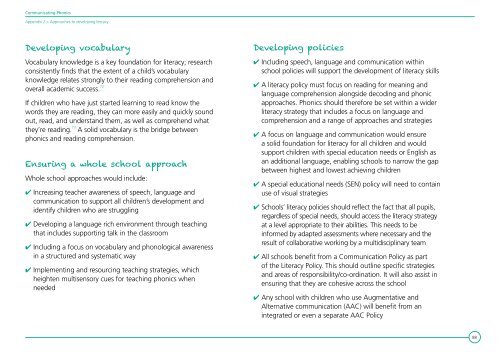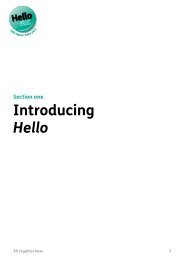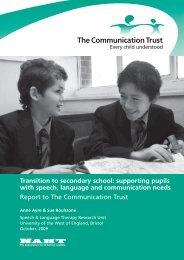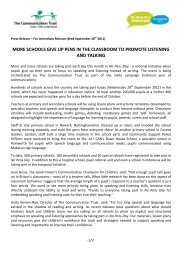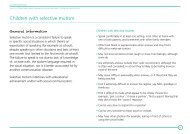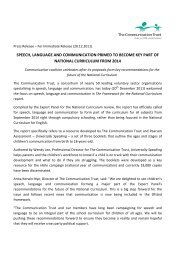Communicating Phonics - The Communication Trust
Communicating Phonics - The Communication Trust
Communicating Phonics - The Communication Trust
You also want an ePaper? Increase the reach of your titles
YUMPU automatically turns print PDFs into web optimized ePapers that Google loves.
<strong>Communicating</strong> <strong>Phonics</strong>Appendix 2 > Approaches to developing literacyDeveloping vocabularyVocabulary knowledge is a key foundation for literacy; researchconsistently finds that the extent of a child’s vocabularyknowledge relates strongly to their reading comprehension andoverall academic success. 72If children who have just started learning to read know thewords they are reading, they can more easily and quickly soundout, read, and understand them, as well as comprehend whatthey’re reading. 73 A solid vocabulary is the bridge betweenphonics and reading comprehension.Ensuring a whole school approachWhole school approaches would include:✔ Increasing teacher awareness of speech, language andcommunication to support all children’s development andidentify children who are struggling✔ Developing a language rich environment through teachingthat includes supporting talk in the classroom✔ Including a focus on vocabulary and phonological awarenessin a structured and systematic way✔ Implementing and resourcing teaching strategies, whichheighten multisensory cues for teaching phonics whenneededDeveloping policies✔ Including speech, language and communication withinschool policies will support the development of literacy skills✔ A literacy policy must focus on reading for meaning andlanguage comprehension alongside decoding and phonicapproaches. <strong>Phonics</strong> should therefore be set within a widerliteracy strategy that includes a focus on language andcomprehension and a range of approaches and strategies✔ A focus on language and communication would ensurea solid foundation for literacy for all children and wouldsupport children with special education needs or English asan additional language, enabling schools to narrow the gapbetween highest and lowest achieving children✔ A special educational needs (SEN) policy will need to containuse of visual strategies✔ Schools’ literacy policies should reflect the fact that all pupils,regardless of special needs, should access the literacy strategyat a level appropriate to their abilities. This needs to beinformed by adapted assessments where necessary and theresult of collaborative working by a multidisciplinary team✔ All schools benefit from a <strong>Communication</strong> Policy as partof the Literacy Policy. This should outline specific strategiesand areas of responsibility/co-ordination. It will also assist inensuring that they are cohesive across the school✔ Any school with children who use Augmentative andAlternative communication (AAC) will benefit from anintegrated or even a separate AAC Policy88


